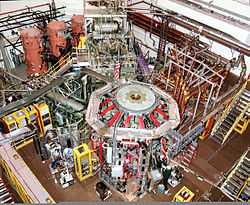National Spherical Torus Experiment
 | |
| Type | Spherical tokamak |
|---|---|
| Operation date | 1999– |
| Major radius | 0.85 m |
| Minor Radius | 0.68 m |
| Magnetic field | 0.3 T |
| Heating | 11 MW |
| Plasma current | 1.4 MA |
The National Spherical Torus Experiment (NSTX) is an innovative magnetic fusion device based on the spherical tokamak concept. It was constructed by the Princeton Plasma Physics Laboratory (PPPL) in collaboration with the Oak Ridge National Laboratory, Columbia University, and the University of Washington at Seattle.
The spherical tokamak is an offshoot of the conventional tokamak design. Proponents claim that it has a number of practical advantages over these devices, some of them dramatic. For this reason the ST has seen considerable interest since it was introduced in the late 1980s. However, development remains effectively one generation behind mainline efforts like JET. Other major experiments in the field include the pioneering START and MAST at Culham in the UK.
First plasma was obtained on NSTX on Friday, February 12, 1999 at 6:06 p.m. NSTX is being used to study the physics principles of spherically shaped plasmas—hot ionized gases in which nuclear fusion will occur under the appropriate conditions of temperature and density, which are produced by confinement in a magnetic field.
Magnetic fusion experiments use plasmas composed of one or more of the isotopes of hydrogen. For example, in 1994, PPPL's Tokamak Fusion Test Reactor (TFTR) produced a world-record 10.7 megawatts of fusion power from a plasma composed of equal parts of deuterium and tritium, the fuel mix likely to be used in commercial fusion power reactors. NSTX is a "proof of principle" experiment and therefore employs deuterium plasmas only. If successful it will be followed by similar devices, eventually including a demonstration power reactor, burning deuterium-tritium fuel.
NSTX produces a plasma that is shaped like a sphere with a hole through its center (a "cored apple" profile; see MAST), different from the doughnut-shaped (toroidal) plasmas of conventional tokamaks. The low aspect ratio A (that is, an R/a of 1.31, with the major radius R of 0.85 m and the minor radius a of 0.65 m) experimental NSTX device has several advantages including plasma stability through improved confinement, but requires a very careful design of the toroidal and poloidal field coils, vacuum vessels and plasma-facing components. Moreover, this innovative plasma configuration has the advantage of being able to confine a higher pressure plasma than a doughnut tokamak of high aspect ratio for a given, confinement magnetic field strength. Since the amount of fusion power produced is proportional to the square of the plasma pressure, the use of spherically shaped plasmas could allow the development of smaller, more economical and more stable fusion reactors. NSTX's attractiveness may be further enhanced by its ability to trap in a high "bootstrap" electric current. This self-driven internal plasma current would reduce the power requirements of externally driven plasma currents required to heat and confine the plasma.
References
- "National Spherical Torus Experiment". Princeton Plasma Physics Laboratory. Retrieved 2014-03-02. - Original source for this article was an earlier version of this page.
- "Schematic diagram of NSTX". Princeton Plasma Physics Laboratory. Retrieved 2009-08-07.
External links
- The National Spherical Torus Experiment (NSTX) official site
- Overview of The National Spherical Torus Experiment from PPPL
| ||||||||||||||||||||||||||||||||||||||||||||||||||||||||||||||||||||